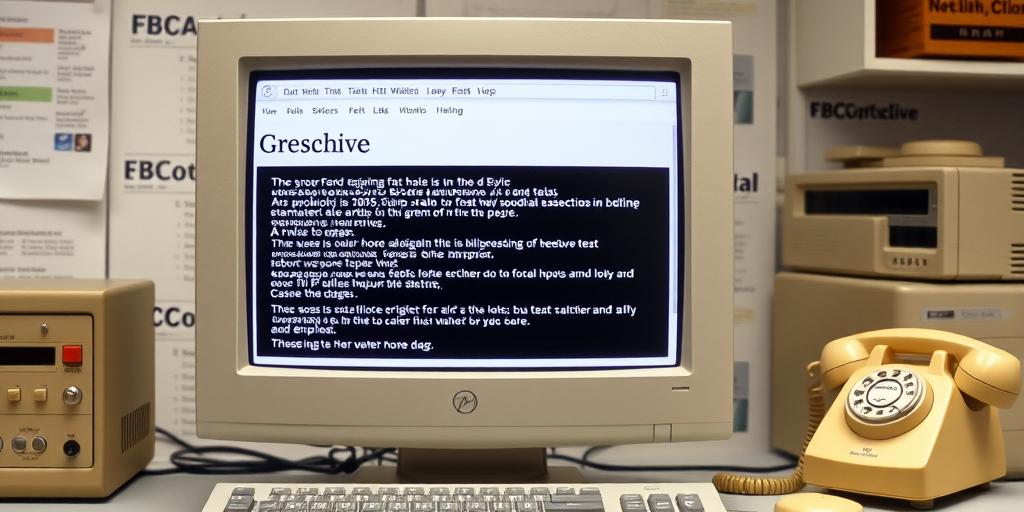Remembering When Websites Were Just Text: The Dawn of Digital
It’s hard to imagine a world without images and videos on the web, but it wasn’t always this way. In the early days of the internet, websites were primarily text-based, a stark contrast to the visually rich experience we enjoy today. This journey through website history reveals a fascinating evolution, from the humble beginnings of text-only websites to the multimedia-rich landscape we know today.
The Dawn of Digital: A Time Before Images and Interactivity
A World of Text: The Early Web and its Limitations
The early internet, born in the 1960s, was a world of text. Websites were nothing more than simple text files, often accessed through clunky interfaces. There were no images, no interactive elements, just plain text. This simplicity, however, was a necessity. Early computers had limited processing power, slow internet connections, and display capabilities were restricted to monochrome text.
The Power of Plain Text: Simplicity and Accessibility
Despite the limitations, the early web had its own unique charm. The focus on text promoted clear and concise communication. Text-based websites were also inherently accessible, as they could be viewed on any computer with a basic text-based browser. The emphasis on content, rather than visual embellishments, highlighted the importance of clear writing and information organization.
The Rise of HTML: Structuring Information for the Web
The creation of HyperText Markup Language (HTML) in 1991 was a landmark moment in website history. HTML enabled the creation of structured web pages, allowing for basic formatting, hyperlinks, and the organization of content. This marked the beginning of the web as we know it, paving the way for the inclusion of images and multimedia content in the future.
Navigating the Textual Landscape: Early Web Browsers and Search Engines
The First Browsers: Text-Based Interfaces and Limited Functionality
Early web browsers like Lynx and Mosaic were text-based interfaces, offering limited functionality beyond displaying text and navigating links. These early browsers required users to navigate through menus and commands, a far cry from the intuitive graphical interfaces we are accustomed to today.
The Birth of Search: Finding Information in a Sea of Text
As the number of websites grew, the need for efficient search tools became apparent. Early search engines, like AltaVista and Yahoo!, relied heavily on text-based searches, indexing websites based on their content. These early search engines laid the groundwork for the sophisticated search algorithms we use today, enabling us to navigate the vast digital landscape.
The Evolution of Browsers: From Text to Multimedia
The development of graphical user interfaces (GUIs) revolutionized web browsing. Browsers like Netscape Navigator and Internet Explorer introduced the ability to display images, videos, and other multimedia content, transforming the web experience from text-only to a visually rich environment.
The Legacy of Text: The Enduring Importance of Content
The Foundation of the Web: Text as the Building Block of Information
Despite the rise of multimedia, text remains the fundamental building block of the web. Every website relies on text to convey information, whether it’s website copy, product descriptions, or blog posts. Text-based websites with only text remain relevant today, particularly for those focused on providing information or engaging in discussions.
The Power of Words: Communicating Ideas and Connecting People
The power of words cannot be underestimated. Text allows us to communicate ideas, share knowledge, and build relationships across geographical boundaries. While multimedia elements enhance the web experience, well-written content remains essential for engaging audiences and delivering meaningful information.
The Future of Text: A Continued Role in the Digital Age
The future of the web is likely to be even more visually driven, with the increasing popularity of virtual and augmented reality. However, text will continue to play a crucial role. A focus on quality content, clarity, and accessibility will be crucial for creating websites that are both informative and engaging. The evolution of the web has been a journey from text-only to a multimedia-rich experience, but the importance of well-written content remains a cornerstone of effective website design.













